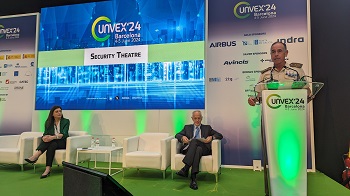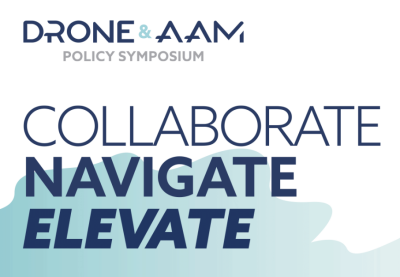Much like on Day 1 of UNVEX, Day 2 opened with a spotlight session that highlighted the many different themes, topics and innovations that were further explored across the conference program. With speakers that highlight the impact of the technology in aerospace, defense and the drone market, the opening provided attendees with insights that defined countless conversations.
 Teresa Riesgo Alcaide is the Secretary General for Innovation, and she joined the session virtually to outline why a ministry responsible for innovation is focused on drones.
Teresa Riesgo Alcaide is the Secretary General for Innovation, and she joined the session virtually to outline why a ministry responsible for innovation is focused on drones.
Alcaide detailed how their next-generation funds are being utilized to develop a strategy for aerospace that convenes all of the actions of the Spanish government. Aerospace has been prioritized for development by the Ministry of Science on account of it being recognized that this is a key sector where R&D is essential.
“We want to be a country of future opportunities and present opportunities,” she told the crowd. “There are new paradigms being opened up like HAPS, and what’s important for us is to consider where things can go with these applications, because the focus for those right now is security, but we envision future opportunities with observation.”
High-altitude platform station (HAPS) drones were the focus of a later presentation, during which Airbus showcased their innovations and the Director General of the police force in Catalonia detailed how their department is using these types of solutions.
 LTG Fernando García González-Valerio is the Spanish Joint Staff Chief, and he took the stage to outline how and why drones represent a truly game-changing technology for military applications in the present, but also how those developments are making them consider how they want to use drones in the future.
LTG Fernando García González-Valerio is the Spanish Joint Staff Chief, and he took the stage to outline how and why drones represent a truly game-changing technology for military applications in the present, but also how those developments are making them consider how they want to use drones in the future.
He called out how drones have become essential weapons in the conflicts in both Ukraine and Gaza, to the point that drones are being used to subdue Russian mechanized units. The four main advantages of UAS technology—limited risk, versatility, low cost and the ability to provide a true tactical surprise—has changed dynamics in these conflicts, but the impact goes far beyond them.
Twenty-five years ago, IED’s were the main threat but today, it’s drones. That look at the past and present has impacted how leaders like LTG González-Valerio are considering how they need to approach adopting and further integrating the technology going forward.
“Drones have truly transformed military operations and right now, we have a limited gap to sort out how to best use these systems,” he told the crowd. “They offer significant advantages and they’ll become more autonomous and hyper-connected, which means we have a limited time to make decisions around what it means for us to take advantage of those opportunities before others do.”
 Margarita Ardao Rodríguez is the General Director for Industrial Strategy and Business Floor, which is responsible for coordinating the activity of the Provincial Councils of its territory. She took the stage to deliver a message about supporting the airspace sector in a way that will make sense for everyone.
Margarita Ardao Rodríguez is the General Director for Industrial Strategy and Business Floor, which is responsible for coordinating the activity of the Provincial Councils of its territory. She took the stage to deliver a message about supporting the airspace sector in a way that will make sense for everyone.
“We’ve made significant efforts to open up the public and private markets,” she said. “That’s why we want you to present your projects to us because we’re supporting the airspace sector in a big way."
All of which speaks to how drones are now actively shaping the current landscape of aerospace, defense, and various markets. This underscores the importance of understanding drone ecosystems of the present to build a solid foundation for the future in multiple sectors and applications.
















Comments